大学汉英翻译教程-Note
新标准大学英语综合教程3课后翻译 英译汉

Unit11.We all sensed we were coming to the end of our stay here,that we would never get a chance li ke this again,and we became determined not to waste it.Most important of course were the fina l exams in April and May in the following year.No one wanted the humiliation of finishing last in c lass,so the peer group pressure to work hard was strong.Libraries which were once empty after f ive o’clock in the afternoon were standing room only until the early hours of the morning,and guys wo re the bags under their eyes and their pale,sleepy faces with pride,like medals proving their dilig ence.我们都觉得在校时间不多了,以后再也不会有这样的学习机会了,所以都下定决心不再虚度光阴。
当然,下一年四五月份的期末考试最为重要。
我们谁都不想考全班倒数第一,那也太丢人了,因此同学们之间的竞争压力特别大。
以前每天下午五点以后,图书馆就空无一人了,现在却要等到天快亮时才会有空座,小伙子们熬夜熬出了眼袋,他们脸色苍白,睡眼惺忪,却很自豪,好像这些都是表彰他们勤奋好学的奖章。
2Tomorrow?It’s all a lie;there isn’t a tomorrow.There’s only a promissory note that we are often not ina position to cash.It doesn’t even exist.When you wake up in the morning it’ll be today again and allthe same rules will apply.Tomorrow is just another version of now,an empty field that will remai n sounless we start planting some seeds.Your time,which is ticking away as we speak(at about60se condsa minute chronologically;a bit faster if you don’t invest your time wisely),will be gone and you’llhave nothing to show for it but regret and a rear-view mirror full of“could haves”,“should h aves”and“would haves”.明天行吗?明天只是个谎言;根本就没有什么明天,只有一张我们常常无法兑现的期票。
lecture 5 汉英词语翻译
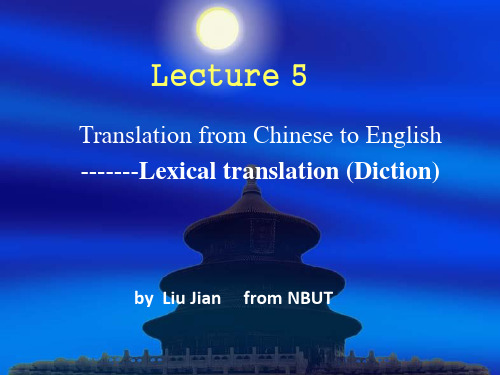
7). 昨天看电影我没有买到好票:
* I did not buy a good ticket for yesterday’s film. I did not buy a good seat for yesterday’s film.
8). 这所全国重点大学为社会输送了大批人才
(batches of )。 * The national heavy university has sent/transported batches of qualified talents to the society. The national key university has prepared batches of qualified graduates for the society. 9). 他们省吃俭用,为的是攒钱买房子。 * They save food and expenses to accumulate more funds to buy an apartment. They live frugally/economically/thriftily to accumulate more funds to buy an apartment.
Appropriateness in word selection-ii
To choose word according to the collocation 2). 好: 好教徒 好父母 好儿女 好妻子 好丈夫 3). 水平: 英语水平 生活水平 游泳水平
2) good a faithful/devout/pious/sincere/ devoted Christian/believer a loving/caring parent an obedient/filial child a virtuous/devoted wife a dutiful/responsible husband 3) level English proficiency/ level living standard swimming skill
大学英语翻译全教程第一讲(完美版)

翻译理论与实践(以《英语翻译教程》南开大学出版社为基础)第一讲翻译概述一、翻译的概念1.广义的翻译指语言与语言、语言与非语言等代码转换和基本信息的传达。
它包括不同语言间的翻译(如英汉互译)语言变体间的翻译(如古今语言、不同方言的互译)、语言与其他交际符号的转换(如把交通规则画成交通标志)。
他对翻译的内容只强调“基本信息”,不强调“完全的忠实”。
也有翻译家提出“理解也是翻译”的理论,这就把语言与思维也包括在广义的翻译里了。
2.狭义的翻译指语言活动,是把一种语言所表达的内容中式地用另一种远表达出来。
这个定义强调“是一种语言活动”,表明它是人类多种交际方式中语言交际的沟通;强调“一种语言到另一种语言”,排除了同一语言间各变体的互译;强调“忠实地”,避免了翻译与释义或改写的混淆。
奈达(Eugene Nida)“Translation consists in reproducing in the receptor language the closest natural equivalent of the source-language message, first in terms of meaning and second in terms of style.”(Nida & Taber: The Theory and Practice of Translation)我们的翻译课讲的就是狭义的翻译,并专指“书面表达内容”,以区别于有独特之处的口译(interpretation)。
二、翻译的分类1.从所涉及的代码性质看,可分为语内翻译(intralingual translation)、语际翻译(interlingual translation)和语符翻译(intersemiotic translation)。
语内翻译是同一种语言见不同语言变体的翻译,如把古汉语译成现代汉语,把黑话译成一般语言(雷子,一方);语际翻译是不同语言间的翻译,是狭义翻译研究的对象;语符翻译是用非文字符号解释文字符号,如图画、手势、音乐符号等。
大学英语翻译教程-第八讲
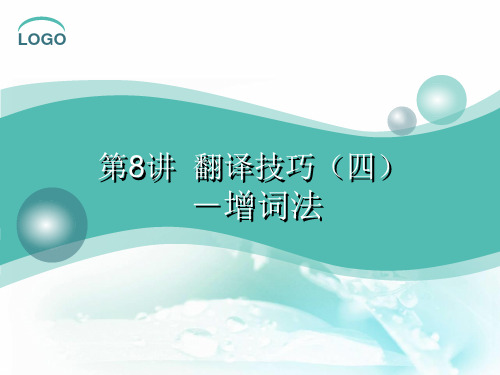
8.1.1 增补回答句中省略的词语
在回答英语一般疑问句时,通常采用省略句。汉译 时,为了使表达清楚、意思完整,有时需要增补省 却的词语。如: (3) Are you hungry? Not very. (4) Shall I bring you a dictionary or an encyclopaedia? Both, please. (5) When are they due to arrive? In about two hours. (6) Can energy be changed from one form into another? Yes, it can.
(22)My teaching, my family and my friends are more than enough to fill my time.
8.2.1增加动词
(23) Sanctions admittedly pressed harder on some countries than others. (24) The molecules get closer and closer with the pressure. (25) Measuring is an intricate problem and long experience is required for its mastery.
8.2.4 增加表示名词复数的词语
(42) Not many yards below the surface, the pressure on each square foot is a matter of tons. (43) Sensor switches are located near the end of each feed belt. (44) From the experiments, scientists learned that ocean currents there are far more erratic than they had thought.
大学实用翻译教程(英汉双向 )第六章 商贸翻译
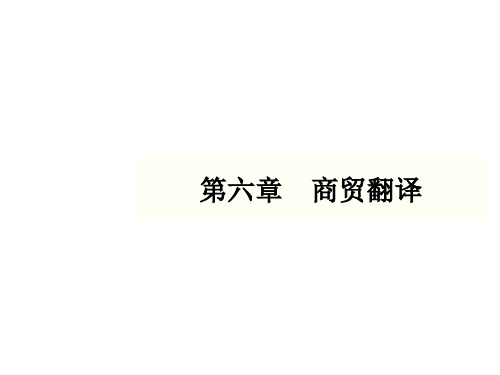
由于国际贸易双方具有非常明确的目的,在其签订合同或起草来往的函电中 往往使用缩略词来简化术语表达。这些缩略语是双方都了解的国际通用的表 达术语,既节省了双方的时间,又能准确表达其目的,所以在实际运用中是 非常流行的,也被贸易双方所接受,这也是学生需要重点学习的。如:
OPEC (The organization of petroleum Exporting Country)石油输出组织。
专业术语:汇付remit 信汇mail transfer 订金down payment 跟单托收documentary collection 缩写词:提单 B/L ( Bill of Landing) 装箱单 P/L (Packing List) 商船 M.V. (Merchant Vessel)
特定含义:他经常向有困难的人主动提供帮助。 He always offers his help to those who meet difficulties.
目的港船上交货(Delivered EX Ship,DES) 未完税交货(Delivered Duty Unpaid,DDU)
目的港码头交货(Delivered EX Quay,DEQ) 完税后交货(Delivered Duty Paid,DDP)
象征性交货( Symbolic Delivery )
良好平均品质(Fair Average Quality, FAQ)
对等样品;回样(Counter Sample) 拼箱货( Less than Container Load, LCL )
国际多式联运(International Multimodal Transport 或 International Combined Transport, 美国也
《大学汉英翻译教程》 第三章 词语的英译与常用技巧

• 鲁迅先生在这里描绘的是一个病入膏肓的人物形象。 “阳文”是指印章或某些器物上所刻或所铸的突出 文字和花纹。如果不深入分析原文的蕴涵意义,将 阳文的“八”译为character "eight" cut in relief, 虽然译出了原文的指称意义,却无法再现鲁迅先生 对形容枯槁的小栓形象的生动的描摹。杨氏夫妇采 用变通手法,用英语中字母“V”倒置的形象生动地 传递了原文的蕴含意义,再现了原文作者笔下真实 细致的形象。
• ⑶ ……只因生得妩媚风流,满学中都送了两个 外号:一个叫“香怜”,一个叫“玉爱”。 (曹雪芹《红楼梦》)
• But on account of their good looks and charm they were nicknamed Sweetie and Lovely. (杨 宪益、戴乃迭译)
research, but his younger brother in fame and gain.
跟前几句都不同。 • ⑤你帮了我们不少忙,这一点儿小意思,请收
下。
• You have helped us a lot. This is a little gift as a token of our appreciation. Please accept it.
• 这里的“意思”指称意义是“略表心意”,属 于汉语文化中按其指称意义来直译。 在汉语中,数词有时只具有象征意义,即 不表示确切的量,只用来形容大小、轻重、 程度等的概念。这类数词在英译时,不必 按其指称意义直接译出,可以按其蕴含意 义,用英语的习惯方法来译。
大学英语实用翻译教程Unit 3(1) 直译与意译
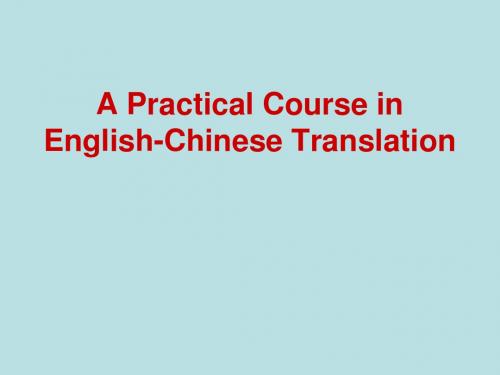
根据《圣经》故事《马太福音》(20: 2-16,Matthew): 葡萄园主招人到园里工作,议定一天一钱银子。他清早雇用了一 批工人,11 小时之后,快收工时,他又雇用了一批。收工时,迟来的 和早来的一样,都获得一钱银子工资。早来晚来,报酬都一个样,何 必早来呢?真是“来得早不如来得巧”,不如在关键、最后决定时刻 来。自从有了这个故事以后,人们便大量使用 at the eleventh hour 这 个成语,含义也固定下来,成为“最后(关键、危急)时刻”。
Liberal Translation 意译
在汉译英时,也可采用类似的方法来表达不为西方读者 所熟悉的意向或含义。 1)两岸同胞要加强交往,促进经济文化交流,继续拓展 领域、提高层次,推动直接“三通”。 The compatriots on both sides of the Straits need to increase contacts, promote economic and cultural exchanges in more areas and at higher levels and push for the resumption of direct links of mail, transport and trade. 2) 我过去受的那些委屈和刺激,比起他来,简直就是小 巫见大巫,算不了什么。 What little pain and adversity I’ve experienced so far are simply nothing compared to what he' s gone through.
3.1.2 意译(Liberal Translation )
21世纪大学实用英语综合教程(第四册)课后翻译答案(有汉语)
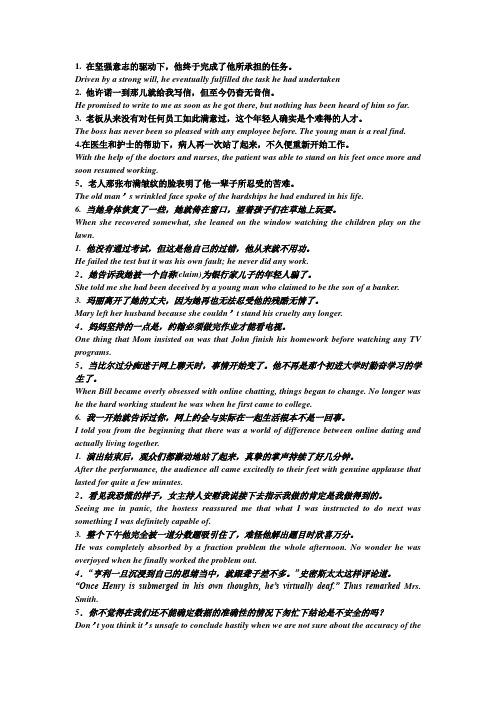
1. 在坚强意志的驱动下,他终于完成了他所承担的任务。
Driven by a strong will, he eventually fulfilled the task he had undertaken2. 他许诺一到那儿就给我写信,但至今仍杳无音信。
He promised to write to me as soon as he got there, but nothing has been heard of him so far. 3. 老板从来没有对任何员工如此满意过,这个年轻人确实是个难得的人才。
The boss has never been so pleased with any employee before. The young man is a real find. 4.在医生和护士的帮助下,病人再一次站了起来,不久便重新开始工作。
With the help of the doctors and nurses, the patient was able to stand on his feet once more and soon resumed working.5.老人那张布满皱纹的脸表明了他一辈子所忍受的苦难。
The old man’s wrinkled face spoke of the hardships he had endured in his life.6. 当她身体恢复了一些,她就倚在窗口,望着孩子们在草地上玩耍。
When she recovered somewhat, she leaned on the window watching the children play on the lawn.1. 他没有通过考试,但这是他自己的过错,他从来就不用功。
He failed the test but it was his own fault; he never did any work.2.她告诉我她被一个自称(claim)为银行家儿子的年轻人骗了。
英汉互译简明教程-Translation Techniques
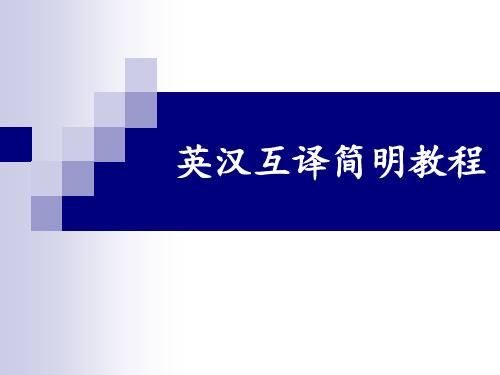
Translation Techniques
Generally speaking, the basic translation techniques that merit our attention and are to be applied in English-Chinese or ChineseEnglish translations include: 1.Diction(遣词用字) 2.Repetition(重译法) 3.Amplification(增译法) 4.Omission(减译法) 5.Conversion(转换法) 6.Inversion(词序调整法) 7.Negation(正说反译,反说正译法) 8.Change of Voices(语态变换法) 9.Division(分译法) bination(合译法)
4.1 Diction
Teaching Contents:
•
Word Meaning
Conceptual Meaning Stylistic Meaning Linguistic Meaning Pragmatic Meaning
•
• •
• •
Choice of Word Meanings
Choice of Word Meanings According to Their Parts of Speech Choice of Word Meanings According to Different Collocation. Choice of Meaning Shifts Between the Abstract and the Concrete. Choice of Affective Meanings. Choice of Contextual Meanings Special Techniques Employed in Translating a word. Deduction(推演法) Transplant(移植法) Extension(引申法) Substitution(替换法) Explanation(释义法) Combination(合并法) Pictographic(图形法) Transliteration(音译法) Zero-Translation(零翻译法) Transliteration + Explanation(音义结合法)
新标准大学英语综合教程1-课后翻译

心之所向,所向披靡英语精读课后翻译英译汉:Unit11.Finally , with my mother red in thefaceand short ofbreath,we find Room8 , Iunlockthedoor ,and we allwalk in .译:等我们终于找到8号房间的时候,妈妈已经涨红了脸,累得上气接不上下气。
我打开门锁,我们都走了进去。
2.She impressesme, and I feelso ignorant that I shouldn’t even breathe the same air asher .译:她给我留下了深刻的印象,我觉得自己太无知了,甚至不配跟她呼吸同样的空气。
3.I don’t know why I have to be introducedto literaturebutthe woman in the admissions officesays if it’s a requirement even though I’ve read Dostoyevsky andMelville and that’sadmirable for someone without a high school educatio n.译:我不知道为什么我非得了解文学。
可是招生办公室的那位女士说,虽然我读过陀思妥耶夫斯基和梅尔维尔的小说,虽然一个没上过高中的人能读这些书的确令人钦佩,但这门课是必修课。
4.I’m inheavenand the first thingtodois buythe requiredtextbooks,cover them with the purple and white NYU book jacketssothat people inthe subway w illlook at meadmiringly .译:我乐得飘飘然了,第一件事就是去买所需要的课本,然后用纽约大学紫白相间的护封把它们套起来,这样地铁里的乘客就会向我投来艳羡的目光了。
王治奎《大学英汉翻译教程》综合练习及详解【圣才出品】
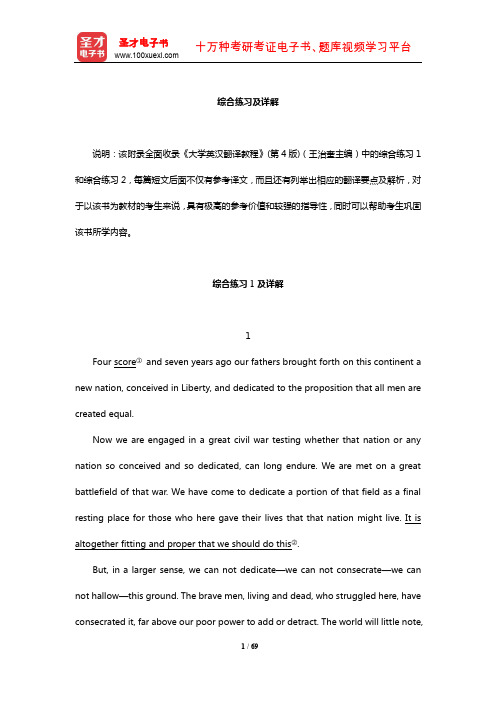
综合练习及详解说明:该附录全面收录《大学英汉翻译教程》(第4版)(王治奎主编)中的综合练习1和综合练习2,每篇短文后面不仅有参考译文,而且还有列举出相应的翻译要点及解析,对于以该书为教材的考生来说,具有极高的参考价值和较强的指导性,同时可以帮助考生巩固该书所学内容。
综合练习1及详解1Four score①and seven years ago our fathers brought forth on this continent a new nation, conceived in Liberty, and dedicated to the proposition that all men are created equal.Now we are engaged in a great civil war testing whether that nation or any nation so conceived and so dedicated, can long endure. We are met on a great battlefield of that war. We have come to dedicate a portion of that field as a final resting place for those who here gave their lives that that nation might live. It is altogether fitting and proper that we should do this②.But, in a larger sense, we can not dedicate—we can not consecrate—we can not hallow—this ground. The brave men, living and dead, who struggled here, have consecrated it, far above our poor power to add or detract. The world will little note,nor long remember what we say here, but it can never forget③what they did here. It is for us the living, rather, to be dedicated here to the unfinished work which they who fought here have thus far so nobly advanced. It is rather for us to be here dedicated to the great task remaining before us—that from these honored dead we take increased devotion to that cause for which they gave the last full measure of devotion—that we here highly resolve that these dead shall not have died in vain—that this nation, under God, shall have a new birth of freedom—and that government of the people, by the people, for the people, shall not perish from the earth④.(From Living Documents of American History)【参考译文】87①年前,我们的先辈在这个大陆上建立了一个以自由为理想,以人人平等为宗旨的新国家。
大学英语实训教程3翻译参考英汉

In recent years, more and more museums in China have been open to the public free of charge. The number of museum exhibitions and visitors to the museum has seen an obvious increase. It has become very common to see that people stand in long queues in front of some widely popular museums. Therefore, these museums must take measures to restrict the number of visitors. Nowadays, the forms of exhibitions become increasingly diverse. Some large museums use advanced technologies such as multimedia and virtual reality to make their exhibitions more attractive. Quite a few museums also hold online exhibitions where people can enjoy the sight of rare and precious exhibits. However, the experience of viewing the exhibits on site is still more appealing to most visitors.近年来,中国越来越多的博物馆免费向公众开放。
博物馆展览次数和参观人数都明显增长。
新编汉英翻译教程核心内容笔记
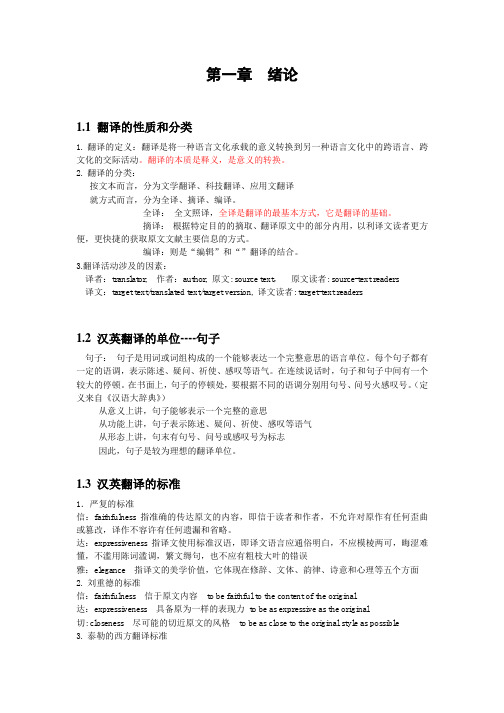
第一章绪论1.1 翻译的性质和分类1. 翻译的定义:翻译是将一种语言文化承载的意义转换到另一种语言文化中的跨语言、跨文化的交际活动。
翻译的本质是释义,是意义的转换。
2. 翻译的分类:按文本而言,分为文学翻译、科技翻译、应用文翻译就方式而言,分为全译、摘译、编译。
全译:全文照译,全译是翻译的最基本方式,它是翻译的基础。
摘译:根据特定目的的摘取、翻译原文中的部分内用,以利译文读者更方便,更快捷的获取原文文献主要信息的方式。
编译:则是“编辑”和“”翻译的结合。
3.翻译活动涉及的因素:译者:translator, 作者:author, 原文: source text,原文读者: source-text readers译文:target text/translated text/target version, 译文读者: target-text readers1.2 汉英翻译的单位----句子句子:句子是用词或词组构成的一个能够表达一个完整意思的语言单位。
每个句子都有一定的语调,表示陈述、疑问、祈使、感叹等语气。
在连续说话时,句子和句子中间有一个较大的停顿。
在书面上,句子的停顿处,要根据不同的语调分别用句号、问号火感叹号。
(定义来自《汉语大辞典》)从意义上讲,句子能够表示一个完整的意思从功能上讲,句子表示陈述、疑问、祈使、感叹等语气从形态上讲,句末有句号、问号或感叹号为标志因此,句子是较为理想的翻译单位。
1.3 汉英翻译的标准1.严复的标准信:faithfulness 指准确的传达原文的内容,即信于读者和作者,不允许对原作有任何歪曲或篡改,译作不容许有任何遗漏和省略。
达:expressiveness 指译文使用标准汉语,即译文语言应通俗明白,不应模棱两可,晦涩难懂,不滥用陈词滥调,繁文缛句,也不应有粗枝大叶的错误雅:elegance 指译文的美学价值,它体现在修辞、文体、韵律、诗意和心理等五个方面2. 刘重德的标准信:faithfulness 信于原文内容to be faithful to the content of the original达:expressiveness 具备原为一样的表现力to be as expressive as the original切: closeness 尽可能的切近原文的风格to be as close to the original style as possible3. 泰勒的西方翻译标准译文应该完全传达原文的思想 a translation should give a complete transcript of the ideas of the original work译文的风格和笔调应与原文一致the style and manner of writing should be of the same character as that of the original译文应像原文一样流畅 a translation should have all the ease of the original compositon4. 张培基的标准—使用语初学者忠实:faithfulness, 忠实于原作的内容和风格通顺:smoothness, 译文语言必须通俗易懂,符合规范5.本书的标准功能相似,语义相符,similarity in function and correspondence in meaning6. 语言的功能A, 信息功能:informative function =所指功能:referential function, 它是语言传达信息,影响他人认知的功能B. 表情功能: expressive function, 它是语言表达言者或作何,即言语始发者的思想感情的功能。
【最新】英汉翻译教程

2021/2/2
27
Ex. Improve the following translation
• 2. She is a valuable acquisition of the company.
• 原译:她是这家公司有价值的收获。
2021/2/2
2021/2/2
34
eg. “You have left the door open.” has different utterance meaning:
2021/2/2
35
“You have left the door open.”
• 原译文:因为,毕竟所有活着的生物, 不论是植物还是动物,死的还是活的都 靠吃某种别的东西生存。
2021/2/2
32
❖ 4. After all, all living creatures live by feeding on something else, whether it be plant or animal, dead or alive.
Job: for some people, it is a job
Subject: to learn translation theory and skills, it is no doubt a science.
Translation is also a good way to develop
The translation of Buddhist scripture from East Han Dynasty to Song Dynasty.
The translation of science and technology works from late Ming Dynasty to early Qing Dynasty.
《大学汉英翻译教程》 第一章 绪论
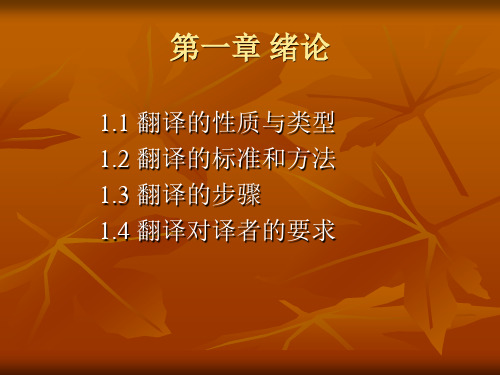
【翻译方法】
所谓的翻译方法,严格来说包括两个内容:一是 译者在翻译过程中为了传达原作内容与形式而采取的 策略、方法;二是译者在翻译过程中解决具体问题的 办法,也称翻译技巧。本节所讲的翻译方法,指的是 第一方面的内容,而第二方面的内容,将在翻译技巧 里阐述。 一说到翻译方法,人们就会自然而然地想到直译 (literal translation)和意译(free translation)。其实, 这并不奇怪。两千多年来,无论在中国还是在西方, 整个翻译史就是一部直译和意译此消彼长、交相辉映 的历史。
综上所述,所谓直译,就是既保持原文内容,又 保持原文形式的翻译方法或翻译文字。译文的语言 (或目的语)与原文的语言(或原语)常常用相同的 表达形式来体现同样的内容,并能产生同样的效果。 在这种情况下,我们就采用直译。所谓意译,就是只 保持原文内容、不保持原文形式的翻译方法或翻译文 字。译文的语言(或目的语)与原文的语言(或原语) 在许多情况下并不用同样的表达形式来体现同样的内 容,更谈不上产生同样的效果。在这种情况下,一般 采用意译为好。 直译和意译的对象可以是包括成语在内的单词和 词组,也可以是句子。下面我们就来分析直译与意译 在单词、成语和句子翻译中的运用。
口译一般指口头翻译,其基本方式有两种: 一是连续传译; 二是同声传(simultaneous interpretation)
笔译就是笔头翻译,就文本类型而言可以分为 非文学翻译和文学翻译两个大类: 前者包括政论体翻译、科技翻译、经贸翻译和 应用文翻译等,后者包括小说翻译、诗歌翻译、 散文翻译和戏剧翻译等;就处理方法而言,翻 译可以分为全译、节译、摘译和编译等
② 月亮 直译:the moon 意译:celestial body, heavenly body, planet, secondary planet, planetoid, orb of night, moon goddess, green cheese, Diana, Luna, Cynthia, queen of night(Shakespeare), chaste and fair (B. Johnson) ④ 太阳 直译:the sun 意译:star of day, solar disk, solar orb, orb, sphere, fireball, ball of fire, eye of heaven, great luminary, lamp of the day, source of light, Helios, Apollo, Hyperion, old sol, Mithras, Shamash, the god of life and poesy and light(Byron)
大学高阶英语教材翻译课文
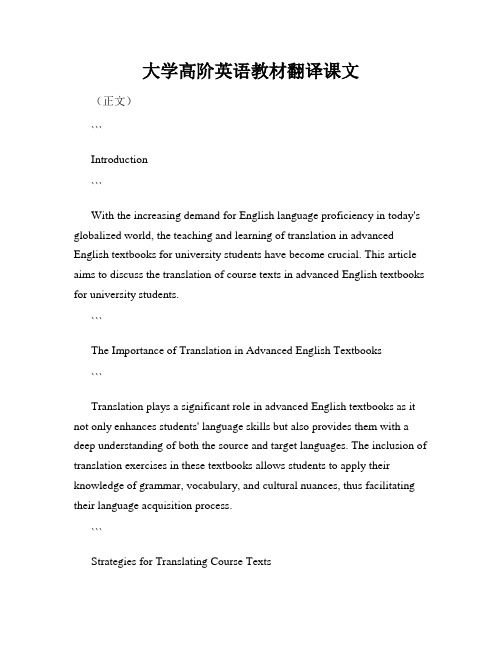
大学高阶英语教材翻译课文(正文)```Introduction```With the increasing demand for English language proficiency in today's globalized world, the teaching and learning of translation in advanced English textbooks for university students have become crucial. This article aims to discuss the translation of course texts in advanced English textbooks for university students.```The Importance of Translation in Advanced English Textbooks```Translation plays a significant role in advanced English textbooks as it not only enhances students' language skills but also provides them with a deep understanding of both the source and target languages. The inclusion of translation exercises in these textbooks allows students to apply their knowledge of grammar, vocabulary, and cultural nuances, thus facilitating their language acquisition process.```Strategies for Translating Course Texts```1. Understanding the Source Text: Before beginning the translation process, students must thoroughly comprehend the source text. They should pay attention to the context, structure, and main ideas conveyed by the original text.2. Analyzing Cultural and Linguistic Differences: Advanced English textbooks often consist of texts originating from various cultures and backgrounds. Students need to be aware of the cultural and linguistic discrepancies between the source and target languages to ensure accurate translation.3. Preserving the Style and Tone: In translation, it is essential to maintain the author's intended style and tone. Students should strive to reflect the original text's voice and register while adapting it to the target language.4. Retaining the Meaning: The primary goal of translation is to convey the meaning of the source text accurately. Students should prioritize semantic equivalence and avoid mistranslations or misinterpretations.5. Proofreading and Editing: After completing the initial translation, students should carefully proofread and edit their work. This step ensures that the final translation is error-free and effectively conveys the intended message.```Challenges in Translating Course Texts```1. Idiomatic Expressions: Idiomatic expressions pose challenges in translation as they often do not have direct equivalents in the target language. Students must employ their creativity and knowledge of both languages to find appropriate alternative expressions.2. Cultural Nuances: Various cultural nuances and references embedded in the source text can be challenging to translate accurately. Students should be sensitive to cultural contexts and use their cultural knowledge to convey the intended meaning in the target language.3. Sentence Structure: Different languages have varying sentence structures, making translation a complex task. Students must carefully analyze the grammatical structure of the original text and ensure its coherence and readability in the target language.4. Ambiguity: Some texts may contain deliberate ambiguity. Translating such ambiguity requires students to make informed decisions while considering the author's intended meaning and maintaining textual integrity.```Conclusion```In conclusion, the translation of course texts in advanced English textbooks for university students is a valuable tool for enhancing language skills and cultural understanding. By employing effective translation strategies and overcoming the challenges posed, students can develop their translation abilities and gain a comprehensive grasp of both the source and target languages.(Note: This is a sample article for the given title. The actual content may vary based on specific requirements and course objectives.)。
英汉汉英翻译实训教程Chapter One Introduction to Translation

[注]:美国当代翻译理论家尤金·奈达(Eugene Nida)提出的与 读者的反应对等的原则基本上也是以读者为取向。
ቤተ መጻሕፍቲ ባይዱ
General Introduction to Translation
英汉汉英翻译实训教程
直译与意译
Chapter One
• 这两种翻译原则流传到今天就是所谓的“直译”和“意译”说 ;
英汉汉英翻译实训教程
Chapter One
Translate another group of sentences to check your progress.
1. There I was at once surrounded by all the other patients. With curiosity in their eyes, they asked me all kinds of questions.
[译文]: 所有病号一下子把我围住了,问长问短,目光好奇。 2. She has many hot potatoes to handle every day.
[译文]: 她每天都要处理很多棘手的问题。 3. We missed him, but we wish him a long and happy retirement.
Every dog has its day. “每只狗都有它的日子。”
General Introduction to Translation
英汉汉英翻译实训教程
Chapter One
以译入语为取向的翻译原则
一味以译文读者的口味为准绳,完全是为了适合读 者的口味而让译文归化,有时甚至不惜曲解原作。
e.g.
Solomon “诸葛亮”
英汉翻译完整教程[2]
![英汉翻译完整教程[2]](https://img.taocdn.com/s3/m/9658a514c5da50e2524d7f1c.png)
Students should do their own work in order to maximize learning. Collaborating on assignments is permitted, but copying another student’s work is prohibited. Similarly, students who are caught copying or plagiarizing will fail the assignment.
1. 增译法
2. 省译法
3. 词类转换
4. 正说反译、反说正译法 5. 翻译练习1、2、3、4
2
第五章:句子翻译技巧(下)
一、教学目的:要求熟练理解句子的翻译技 巧,从而在汉英翻译时做到通顺、准确。 二、教学过程:
1. 重译法
2. 语态变换法
3. 词序调整法
4. 拆译法 5. 翻译练习1、2、3、4
Wednesday
Classroom
Class 1
14:30—16:00 p.m.
A1203
导学——课程要求
Course Description & Requirements
Description:
This course named Translation Theory and Practice aims at cultivating the SS’ ability of translating between E-C and C- E—they have the ability to understand and master some basic theories and techniques about translation. E.g. the brief history of Chinese and western translation theory, the differences between E and C, the eight basic techniques in translation, some methods to deal with the special sentences, etc. In a word, the SS will have the first impression to English language and Chinese, and through these discussions they will have a higher ability in their English writing. It will take us at least a span of 4 lectures to finish one topic in the syllabus.
《大学汉英翻译教程》 第六章 篇章的英译

鉴于篇章的一致性和连贯性,所以篇章的汉英翻译除了要应 用到前面章节所涉及的汉英翻译技巧之外,还要运用到一些 特殊的处理方法。在本章,我们将着重探讨篇章布局和语篇 衔接在篇章汉英翻译中的作用。
6.1 篇章布局
篇章的布局也就是指语篇的结构安排。语篇的结构是某一语 言中组句成篇的特定方式,是一种约定俗成的,相对稳定的 语言使用习惯,是文化因素在语言运用中长期积淀的结果。 汉语篇章的突出特点:一、通常是由主谓词组、动宾词组以 及其他词组组成的句法松散的长句,但只是形散而意不散; 二、对事物叙述的主观性较强;三、对篇章的逻辑关系的处 理呈隐性状态。 英语篇章的突出特点:英语的段落通常比较短,语义相互关 联的几句话就可组成一个段落。在英语中,表达完整意思的 一句话也可以单独构成段落。而汉语中,自然段的信息量通 常会多于英语的自然段。汉语篇章强调段落中心意思的整体 性。所以汉英翻译中常涉及句群结构的调整问题。
本段的英语译文中,将第一季度经济快速增长的原 因用总括的语句一处并置于句首,使之成总领全篇 的主题句。其次,将最近五年经济的持续增长及其 原因单列出来并使之成为今年第一季度经济增长的 重要原因的一部分,接着叙述今年第一季度经济增 长的三个直接原因,使前后两种原因联系得更为紧 密。这两条措施调整了原文的整体结构,使原文的 意义层次步步推进。第三,考虑到钢铁,建材,机 械设备等只是重工业的一部分,所以翻译时对这一 部分进行了适度调整,译成了has stimulated the increase in heavy industries is general and in the production of iron and steel, building materials, machinery and so on, in particular. 通过这些调整,既 消除了语病,也使译文的脉络更加清晰,意义更加 连贯,更接近英文行文规范。
- 1、下载文档前请自行甄别文档内容的完整性,平台不提供额外的编辑、内容补充、找答案等附加服务。
- 2、"仅部分预览"的文档,不可在线预览部分如存在完整性等问题,可反馈申请退款(可完整预览的文档不适用该条件!)。
- 3、如文档侵犯您的权益,请联系客服反馈,我们会尽快为您处理(人工客服工作时间:9:00-18:30)。
Chapter one 2012-3-27
❤翻译可分为口译interpretation和笔译translation。
❤Interpretation can be divided into two types: one is consecutive interpretation, another is simultaneous interpretation.
❤翻译三原则(George Washington Campbell,Alexander Fraser Tytler)
1.原作的意义、意思
2.原作的思想、精神
3.流畅、通顺
❤翻译方法1.直译literal translation 2.意译free translation 3.音译transliteration
❤山雨欲来风满楼The coming events cast their shadows before.
才学最差,叫喊最多The worst wheel of a cart creaks most.
与……狼狈为奸hand in glove with…
乱七八糟at sixes and sevens
千载难逢once in a blue moon
路必有弯,势必有转机It is a long lane that has no turning.
家丑不可外扬It is an ill bird that fouls its own nest.
❤The main principles of TRANSLITERA TION
1.准确读音
2.正确拼写姓名拼写中姓与名要空一格首字母要大写eg. Pu Songling
地名拼写中首字母大写不空格eg. Fujian Guangdong Xi’an
一般来说除地名人名之外其他专有名词英译时首字母要大写如汉Han;
一般名词要小写
3.弄清词源有些词需要追溯到最初发音以利于音译eg.菩萨Bodhisattva
4.约定俗成eg. 孙中山Sun Y at-sen 宋庆龄Soong Ching Ling 陈嘉庚Tan Kah Kee
5.准确回译eg. 纽约New Y ork
6.缩略语复原eg. 闽Fujian 武大Wuhan University
Chapter two 2012-3-28
❤The classification of CULTURE
1.物质文化material culture
2.制度文化institutional culture
3.心理文化mental culture
❤中英思维方式对比
1.中国人注重伦理,英美人注重认知
2.中国人注重整体、偏重综合性思维;英美人注重个体、偏重分析性思维
3.中国人重直觉,英美人重实证
4.中国人重形象思维,英美人重逻辑思维
Chapter three 2012-3-31
❤词语的指称意义与蕴含意义的对比
1.指称意义是词语在交际过程中所表达的字面的最基本的意义,相当于一种约定俗
成的认知
2.蕴含意义的理解与表达eg:His wife was unfaithful to him, and he became a cuckold.
他老婆红杏出墙,给他戴了顶绿帽子。
此处注意红和绿。
❤词语英译与语言语境
1.根据语言语境确定原文词义:“醉心于……”be engrossed in褒be infatuated with
贬
2.根据语言环境选择译文用词:①Mum gave a book as my birthday present .
②It’s raining and I have brought you an umbrella.
3.根据语言语境消除歧义
❤语言环境和词语感情色彩的传达
❤词语英译与文化语境
e.g. 一肚子的酒,几乎全化作醋酸……(钱钟书,《围城》)
The wine in Xinmei’s stomach turned to vinegar in his jealousy.
“醋酸”代表吃醋而不可直接翻译为vinegar
e.g. 今天饭菜不好,请多包涵。
There are best dishes we are able to prepare. Please make yourself at home.
Chapter four 2012-4-3
❤简单句与省译法:①省译特定的范畴词,如“现象”、“局面”等。
E.g. The molecules are perpetually in motion.分子处于永恒的运动状态中。
②省译原文中不言而喻的词语。
E.g. This is the fundamental road to prosperity.这是走向繁荣的最根本的道路。
③省略华而不实的修饰语。
④省略某些动词。
E.g. Mutual understanding is the basis for state-to-state relations.相互了解是发展国与国之间关系的前提。
❤复句与增译法:①语义性增词②结构性增词③为沟通不同文化而增词(专有名词的解释etc。
)
❤长句翻译:①顺译法②断句法③合并法
Chapter five 2012-4-11
❤英语篇章结构方面段落较短,语义相互关联的几句话就可以组成一个段落。
而中文段落所包含的信息量较大。
句群结构调整的问题
❤篇章衔接
Chapter six 2012-4-18
❤小说的特点:①意境和氛围②个性化的语言方式
❤小说的翻译要求:①透过表面意义、看到文字的精神;
e.g.: When you are getting on in years, you tend to have a feeling that seems rather odd, but, in fact, not very much so. 人到了老年,会有一种似乎奇怪又不奇怪的现象。
②熟谙英汉两种语言,译文浑然一体
e.g.: Having studied at the school for one year, I found that my grades had gone far apart: my Chinese(called “national language”then) was top of the class and so was my fine art(called “drawing” at that time); but in English I brought up the rear; in other subject, I was just above average…As a twelve-or-thirteen-year-old junior school student, I was naughty you bet, and my naughtiness also topped the class.
入学之后,一年下来,我的各门功课就相差太悬殊了!语文(当时叫国文)全班第一;美术(当时叫图画)全班第一;而英语(当时叫英文)全班倒数第一……作为一个十二、三岁的初中生,爱玩爱闹,我的顽皮程度,可能也是全班第一。
